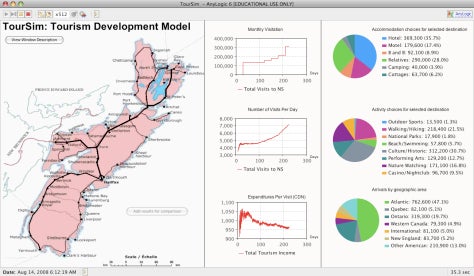I’ve made some major alterations to TourSim, both in the data that it relies on, and the types of experimentation it supports. I’m thinking that this is going to make TourSim much more usable for tourism planning, and begins to incorporate many of the ideas of complexity science (such as adaptation) into TourSim.

First, TourSim now uses tourist preference data from the 2004 Nova Scotia Tourist Exit Survey. This survey has a wider range of accommodation and activity options, and the types of categories represented relate much more intuitively to the types of tourism products available in Nova Scotia. Additionally, the number of responses included in the Tourist Exit Survey is considerably larger than the CTS and ITS I have previously been using. The Tourist Exit Survey also segments tourists based on generating market (Atlantic, Quebec, Ontario, Western Canada, New England, Other USA, and International). Each class of tourist has their own range of activity and accommodation preferences, and you can now see the percentage of each market that is arriving in Nova Scotia.
I’ve also improved the destination adaptation function. This is designed to represent destination development in response to high levels of visitation. Several steps are used to model this function:
- Destination Capacity. Each destination has a maximum capacity for visits, based on occupancy data provided by a mandatory reporting program conducted by the Nova Scotia Department of Tourism, Culture, and Heritage. While this capacity varies considerably from season to season, this occupancy limit represents the maximum accommodation capacity if all accommodations are open.
- Every month, the destination examines the number of tourists who have visited in that month. If the destination is at 80% of its capacity (this threshold is adjustable by the user), then the destination increases its capacity by 5% (this percentage again can be adjusted by the user).
- Advertising: This adaptation function also works for destinations that don’t come close to their capacities. If a destination is below 30% of their capacity, the destination “advertises” and raises the likelihood that it will be randomly selected for evaluation by the tourist. Of course, this isn’t exactly how advertising works, but in the simplified world of TourSim, things are a bit different.
All of these variables can be manipulated by you, the user at the start of the model. Like with other versions you can select specific destinations to focus on, and compare simulation results produced with different variables. Check out the new scenario and let me know what you think!
Cheers,
Peter